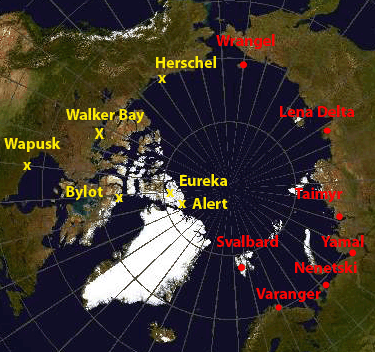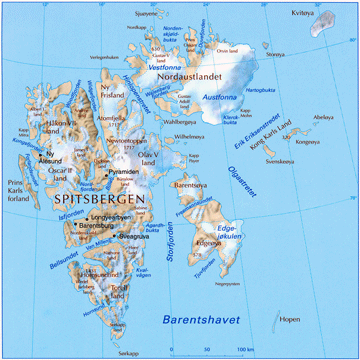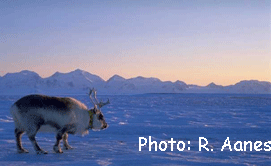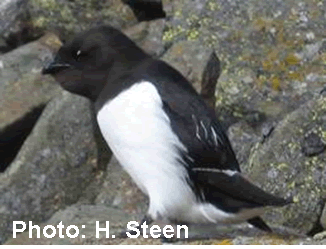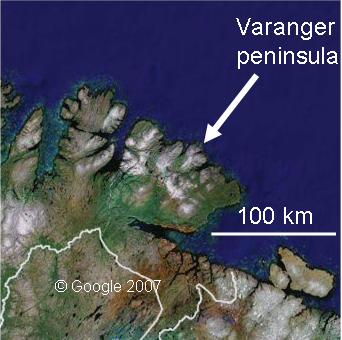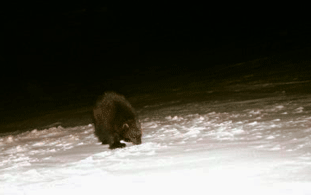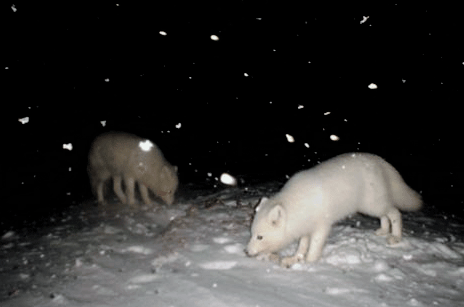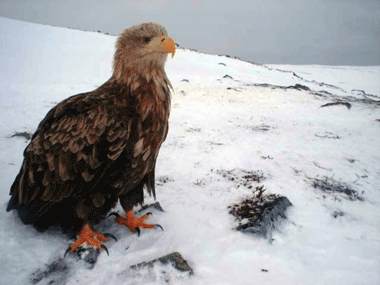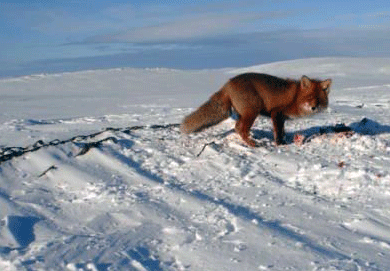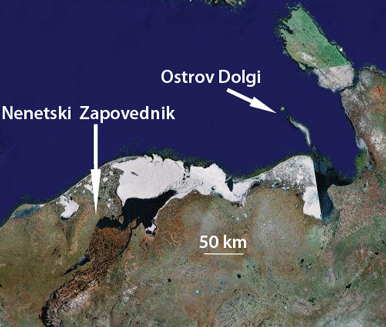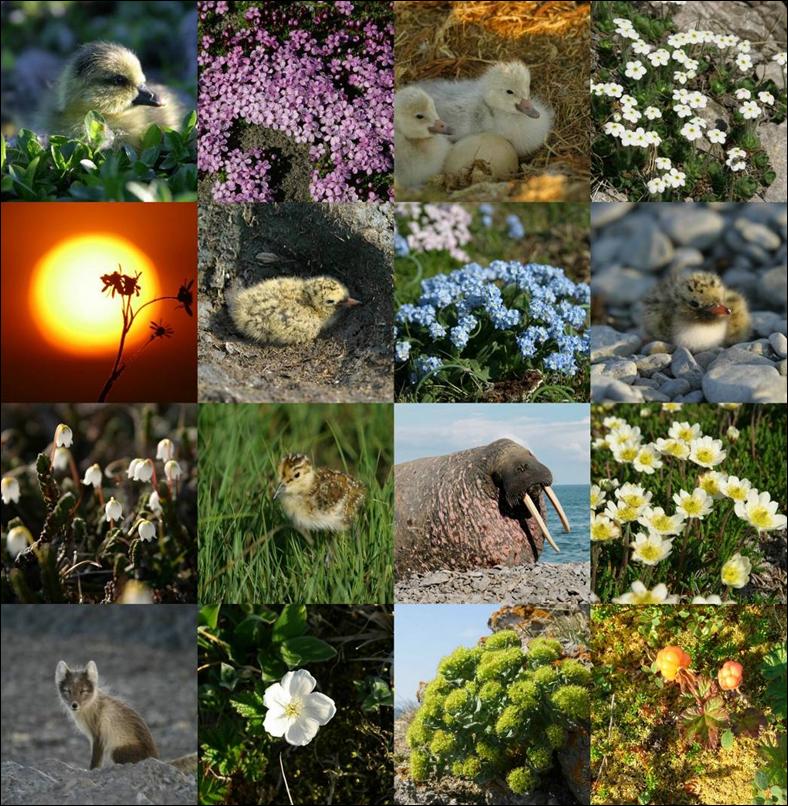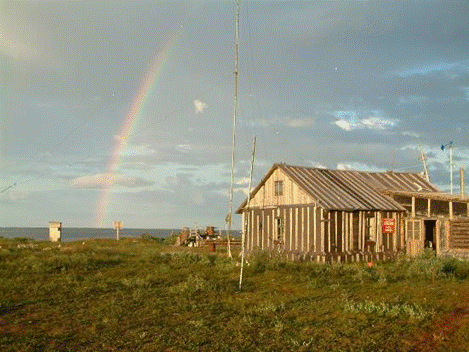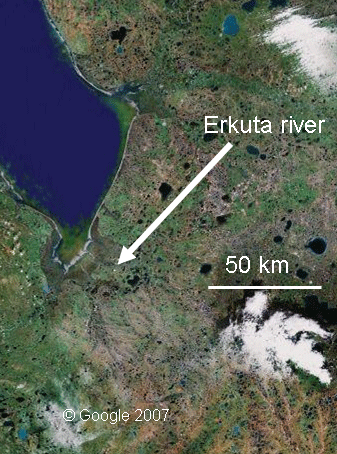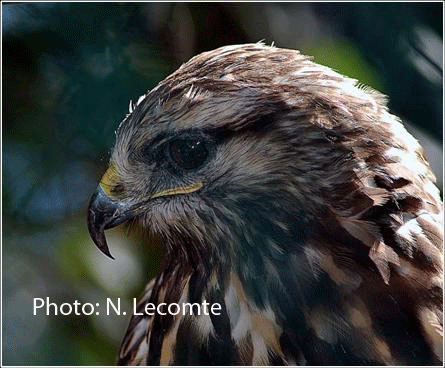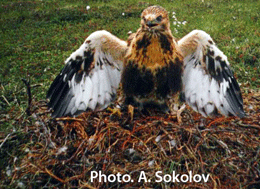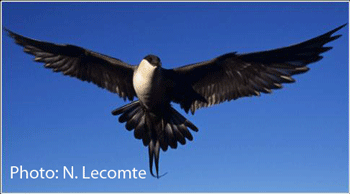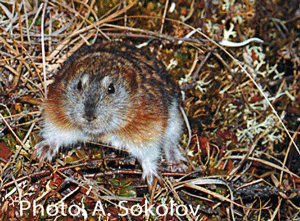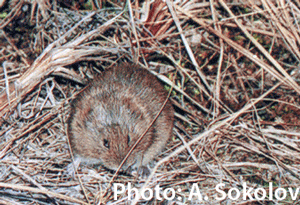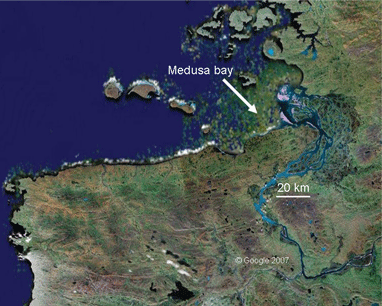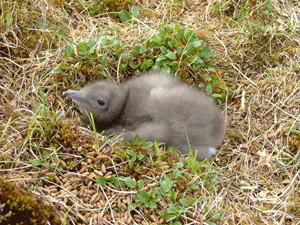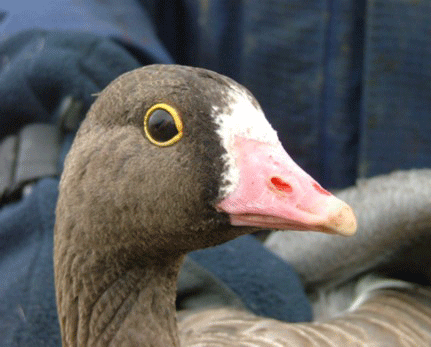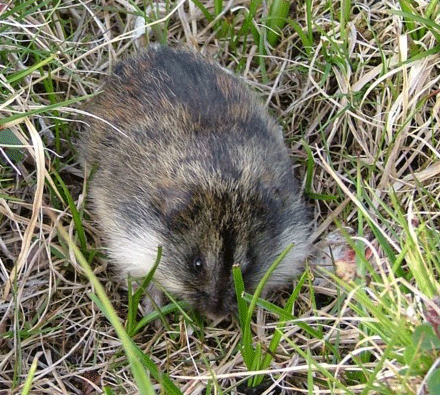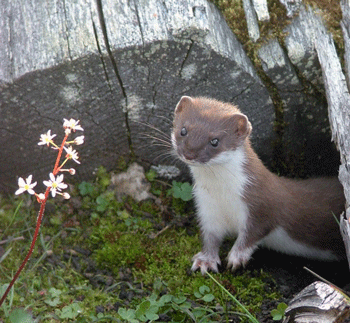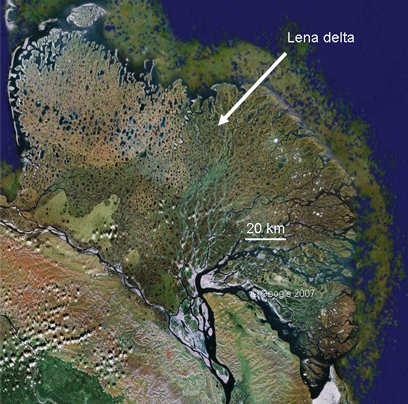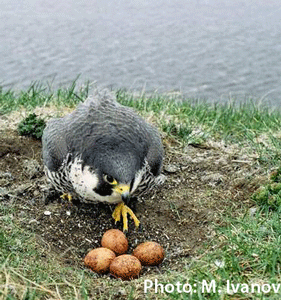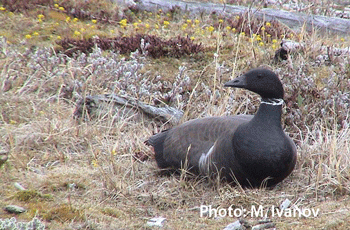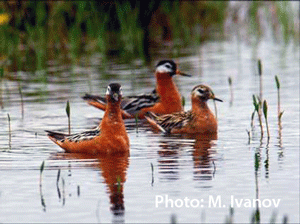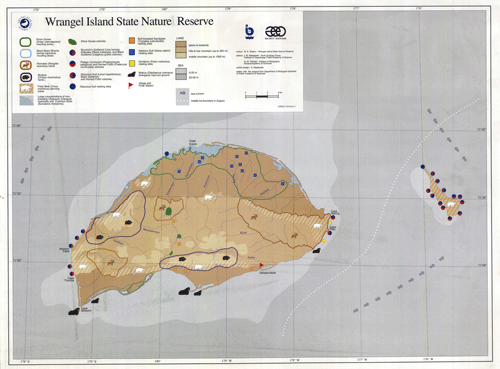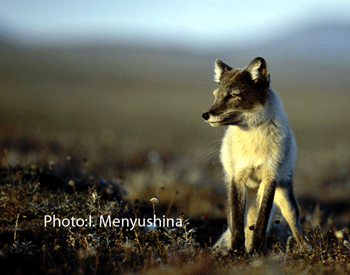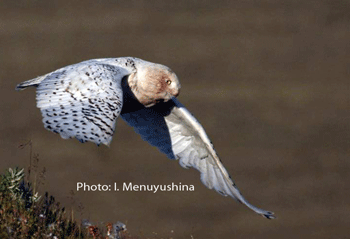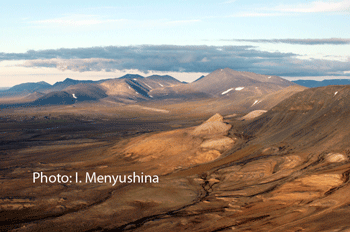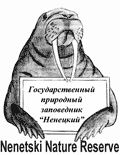
An International Polar Year initiative to use predators as indicators of arctic changes
| |
| Home |
| Project Structure |
| The team |
| Field sites |
| Publications |
| Isotopes |
| News |
| Workshops |
FIELD SITES towards a circumpolar monitoring
CLICK ON THE LOCATION YOU WANT |
|
|
|
Field site 1. Svalbard: Isfjorden & Ny-Ålesund, Norway Site responsibles: Ronny Aanes, Eva Fuglei and Harald Steen, Norwegian Polar Institute Coordinates: 78°30'N 18°00'E Tundra zone: Middle - High arctic Climate: Atlantic region (Fig. 3), frequent thaw/freeze periods in winter Food web structure and dynamics: Vegetation: mosaic of various types as middle to high arctic tundra Herbivores: No lemming or native voles, only a very local introduced population of sibling vole (Microtus rossiae meridionalis), Svalbard reindeer (Rangifer tarandus platyrhynchus) present year round, not migratory; Svalbard ptarmigan (Lagopus muta hyperborea) is the only resident bird; Geese (Branta leucopsis, Branta bernicla, Anser brachyrhynchus) Predators: arctic skua (Stercorarius parasiticus); arctic fox (Vulpex lagopus)Trophic interaction cycles: none Marine subsidies: High. Seabirds, carcasses of seals Previous and ongoing research activities:Long time monitoring series on reindeer since 1978 and 1979, arctic fox since 1997, ptarmigan since 2000, sibling vole since 1989, geese since mid 1980's, seabirds since 1988 Infrastructure: Well developed in Longyearbyen and Ny-Ålesund, regular flights every week |
|
Field site 2. Varanger peninsula, Norway Site responsible: Rolf A. Ims and Nigel G. Yoccoz, University of Tromsø Coordinates: 70°20’N, 30°00’E Tundra zone: Southern arctic (at the border to sub-arctic/northern boreal) Climate zone: Atlantic region (Fig. 3), mild winters with relatively high winter Variability
Food web structure and dynamics: Vegetation: Erect shrub tundra Herbivores: Norwegian lemming (Lemmus lemmus); voles (Clethrionomys rufocanus and Microtus oeconomus); hare (Lepus timidus); ptarmigan (Lagopus) spp.; migratory semi-domestic reindeer Predators: red fox (Vulpes vulpes); wolverine (Gulo gulo); golden eagle (Aquila chrysaetos); raven (Corvus corax); Falco spp.; mustelids (weasels and stoats), arctic fox (rare), rough-legged buzzard (Buteo lagopus), long-tailed skua (Stercorarius longicaudus), arctic skua and snowy owl (Bubo scandiacus) (rare) Trophic interaction cycles: 4-5 years, relatively low amplitude Marine subsidies: Moderate – low
Previous and ongoing research activities: “The Ecosystem Finnmark” and “Arctic fox in Finnmark” projects 2003-2007 focusing on trophic interactions within the plant based food web. Monitoring of small rodents since 1988
Infrastructure: Well developed as the Varanger peninsula is inhabited. |
|
Field site 3. Nenetski Zapovednik and Ostrov Dolgi, Russia Site responsible: Andrey S. Glotov, Nenetski NatureReserve Coordinates: Ostrov Dolgi (island): 68.8°N, 59°E Nenetski Zapovednik (mainland): 68°-69°N, 52°-54°ETundra zone: southern and typical tundra zone. Climate zone: Atlantic region, but colder winters than Varanger Food web structure and dynamics: Vegetation: arctic tundra (no shrubs) on Ostrov Dolgi, shrub tundra on the mainland Herbivores: Lemmings (mostly Dicrostonyx torquatus, but also Lemmus sibiricus), voles (Microtus spp.), ptarmigan and geese. Muskrat (Ondatra zibethicus) and water voles (Arvicola terrestris) are increasing in numbers. About 5000 domestic reindeer winter in the area of the Nature reserve. No rodents, but large breeding population of geese and eider (Somateria mollissima) on the island Ostrov Dolgi. Predators: arctic fox, red fox, wolverine and wolves (Canis lupus). Resident arctic foxes are also on Ostrov Dolgi. Birds of prey: snowy owls, rough-legged buzzard, peregrine falcon. No birds of prey on Ostrov Dolgi Trophic interaction cycles: Cyclic with unknown periodicity and amplitude. No cycles on Ostrov Dolgi Marine subsidies: From strong (Ostrov Dolgi) to low/moderate on mainland Previous and ongoing research activities: Monitoring of the Arctic fox population is carried out since 2003 by the nature reserve (A. Glotov), and for the last 20 years by the researchers from the University of Arkhangelsk. The focus is on population density, sex and age distribution, and projections for the evolution of the population size. On Ostrov Dolgi mapping of species and monitoring since 2002. Arctic foxes are trapped in the area and A. Glotov has contacts with trappers, samples for stable isotope analysis will be available Infrastructure: Field station near Nature reserve, which is accessible by boat from Naryan-Mar. On Ostrov Dolgi field camp, accessible only by helicopter (1.5 hours one way from Naryan Mar) |
|
Field site 4. Yamal: River Erkuta, Russia Site responsible: Alexander Sokolov, Ural Division Russian Academy of SciencesCoordinates: 68°13N, 69°09E Tundra zone: southern tundra Climate zone: Atlantic region, cold winters with relatively variable winters
Food web structure and dynamics: Vegetation: shrub tundra Herbivores: Dicrostonyx torquatus, Lemmus sibiricus, Microtus middendorfii, M. gregalis, Clethrionomys rutilus. M. middendorffi and D. torquatus are the most commonspecies. Other herbivores are ptarmigan, hare, geese. Domestic reindeer migrate through the site in spring and fall (3000-4000), about 300 overwinter. Predators: Arctic foxes (reproduce in the area, and migrate in larger numbers through it in spring and fall), wolves (a problem for reindeer herder, hunted), weasel and ermine. In general in the Yamal region, lynx (Lynx lynx), brown bears ( Ursus arctos) and red foxes spread northward. Avian predators in the area include rough-legged buzzard, peregrine falcon, pomarine (Stercorarius pomarinus), long-tailed and arctic skuas, pallid (Circus macrorus; observed first time in 2003 at Erkuta last year) and hen harrier (Circus cyaneus), short-eared owls (Asio flammeus). Snowy owls are more common in winter. Trophic interaction cycles: medium amplitude, period of 3-4 years.
Marine subsidies: probably low
Previous and ongoing research activities: Monitoring of small rodent densities using standard trap lines since 1998, the populations experience multi-annual density fluctuations with medium amplitude and a period of 3-4 years. During the same time period predator populations have been observed on a study plot of 100km 2 . Nests and breeding success is recorded, and fox dens are inspected. Arctic foxes are trapped in the area. A. Sokolov traps himself and has contacts to trappers
Infrastructure: the site can be reached from Labytnangi by car (220 km), field camp; motor boat, generator and satellite telephone are available. The field plot is situated 6 km from a trading point for reindeer herder (faktoria) |
|
Field site 5. Taimyr: Medusa Bay, Russia Site responsible: Bart S. Ebbinge, Alterra- Ecosystem CenterCoordinates: 73.36°N, 80.53°E Tundra zone: southern part of the arctic tundra zone, Pyassina delta in the arctic tundra zone Climate zone: Siberian region Food web structure and dynamics: Vegetation: tundra with dwarf shrubs and herbs. Meadow like vegetation on slopes with southern exposition and in depressions. Herbivores: lemmings Lemmus sibiricus and Dicrostonyx torquatus, the first considerably more abundant than the second. Other herbivores are hare, ptarmigan, geese and reindeer, which migrate to Medusa Bay each summer, but reach the Pyassina Delta only in warm years. Muskox (Ovibos moschatus; reintroduced to eastern Taimyr) have been seen. Predators: arctic foxes, stoat, a few wolves. Snowy owl, rough-legged buzzard, peregrine falcon (Falco peregrinus) and the three species of skuas. Trophic interaction cycles: high amplitude, (2-) 3-4 years period Marine subsidies: moderate-high Previous and ongoing research activities: Monitoring of lemmings at Medusa Bay since 1993, with trapping carried out in most years and qualitative observations in some. The breeding activity of snowy owls and arctic foxes observed within studies focusing on breeding success of geese and waders. Similar observations have been carried out in the Pyassina Delta in 1993-1995 and 2002, 2004-2005, and will be carried out this year. Arctic foxes are trapped in the area and DE has contacts to trappers Infrastructure: The Willem Barents field station in Medusa Bay (Great Arctic Nature Reserve) 20 km south of the village Dickson (accessible by regular flights, bad and expensive connection). The station can be reached by snow scooter, chain car or boat. It is relatively well equipped (heating, generator) and quite expensive in drift. A field camp consisting of several huts has been established in the Pyassina Delta by ornithologists from the Netherlands in 1993. Accessible by helicopter only |
|
Field site 6. Lena Delta, Russia Site responsible: Vladimir Pozdnyakov, International Biological Station “Lena-Nordenskjöld” Coordinates: 72°-74°N, 120°-129°E Tundra zone: mostly northern sub-arctic tundra zone, arctic tundra zone in the northernmost part Climate zone: Siberian region, very cold, stable winters Food web structure and dynamics: Vegetation: Various vegetation types in different parts of the area Herbivores: Lemmus sibiricus and Dicrostonyx torquatus, the first one about three times more common than the second. Microtus gregalis and M. middendorffi occur at low densities in the southern part of the delta. About 3000-4000 reindeer on the territory of the delta (last census in 1994), and 80 muskox (reintroduced in 1996). Other herbivores are geese, swans and eiders Predators: Arctic fox, ermine, stoat and a few wolves. Birds of prey are snowy owls, rough-legged buzzard, peregrine falcon and three species of skuas Trophic interaction cycles: Lemmings experience multi-annual density fluctuations with a period of 3-4 years (20 peaks in the last 69 years, 12 3-years cycles, 6 4-years cycles and 1 2-years period between two peaks) Marine subsidies: relatively high Previous and ongoing research activities : information about snowy owls from about 30 years of observation. V. Pozdnyakov works in the delta every summer since 1992 and registers observations of all animals, especially birds. Nature reserve workers (Lena Delta Nature Reserve) write down qualitative observations each year since 1986. Arctic foxes are trapped for personal needs by local people Infrastructure: International biological station Lena-Nordenskjold (Department of Nature Protection, republic Sakha(Ya)) about 65km from the village Tiksi. The station has a good standard, can be reached by snow-scooter, boat, chain car or helicopter depending on the season. Expensive drift. Other stations exist, for example the meteorological station Stolb or a field station of the Lena Delta Nature Reserve on the island Tit-Ary, accessible by boat |
|
|
|
Field site 7. Wrangel Island, Russia Site responsibles: Nikita Ovsyanikov and Irina Menyushina, Wrangel Island State Nature Reserve Coordinates: 71°20'N 179°30'E Tundra zone: arctic tundra zone but due to its unique history as a never glaciated region it has a considerably higher biodiversity (both plants and animals) than any otherregion at this latitude Climate zone: Pacific region; cold winters with influence of Pacific air masses Food web structure and dynamics: Vegetation:Various tundra vegetation types in different parts of the island Carnivores: lemmings Dicrostonyx vinogradovi and Lemmus sibiricus portenkoi. Reindeer and muskox were introduced during the 20th century. Large colonies of geese Predators: Arctic fox, wolverine and wolves. Avian predators include snowy owl, gyrfalcon and peregrine falcon, short-eared owl and pomarine and long-tailed skuas. Trophic interaction cycles: period of 3-4 years. Marine subsidies: moderate Previous and ongoing research activities: Long-term study of Arctic foxes started in 1980. Since 1986, also the population of snowy-owls is monitored, and data on skuas are collected. Other predators included in the studies are wolverines and wolves. Focus on abundance, distribution, population structure and dynamics, breeding success, social structure, foraging behavior and biocoenotic relations. An additional focus is the colonies of snow geese and eiders forming under the protection of snowy owls. Lemming opulations monitored since 1972 (snap-trapping in earlier years and winter nest counting and active den counts more recently) Standard methods developed over years of research in the island are used for each species. Data about predators from the 1970s are also available. Snow goose colonies and other bird populations are also subject of ongoing studies. As the whole island is a nature reserve, there is no fox trapping on Wrangel islandInfrastructure: Wrangel island can only be reached by helicopter from the village Pevek. Field research stations exist on the island. There is no fuel or other supplies on the island, so that everything has to be brought from the mainland. Part of N. Ovsyanikov’s current management activities are aimed at developing the old facilities into a modern station of international significance |
|
|
|
|
![]()
RUSSIAN ACADEMY OF SCIENCE |
||
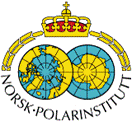
|
|
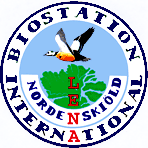 |
IPY-Arctic Predators project
Department of Biology, University of Tromsø and Norwegian Polar Institute N-9037 Tromsø, Norway
Phone: +47 77 64 62 72
© 2010
ARCTIC PREDATORS
- Website design by Nicolas Lecomte
